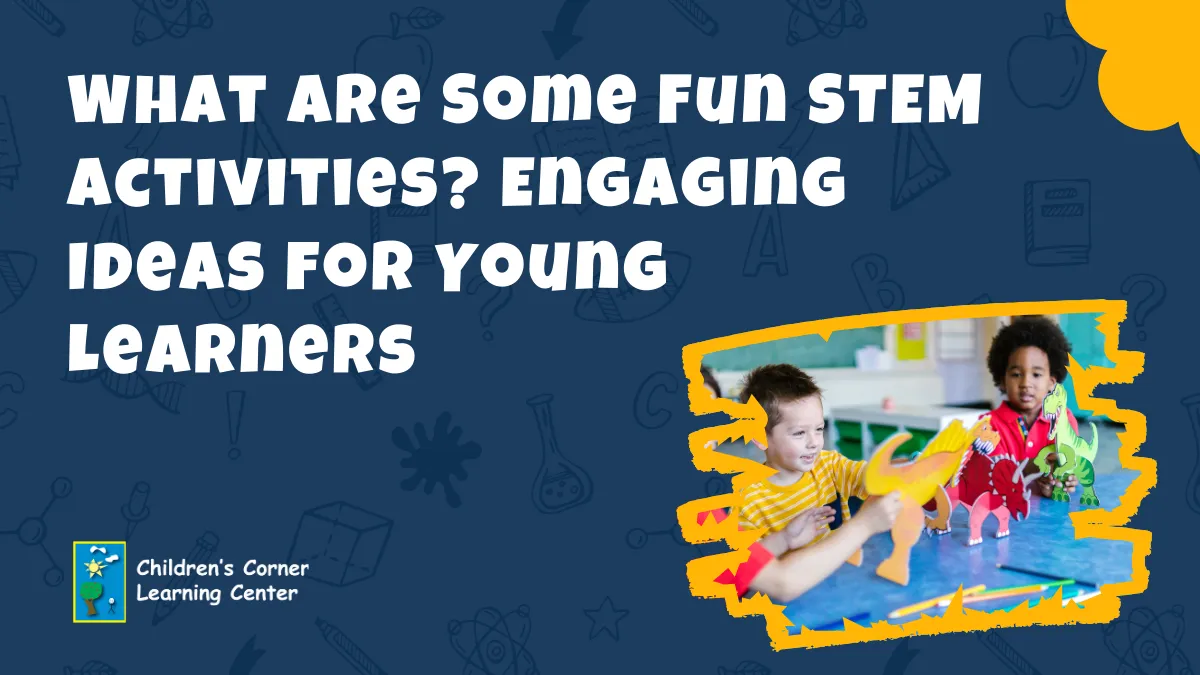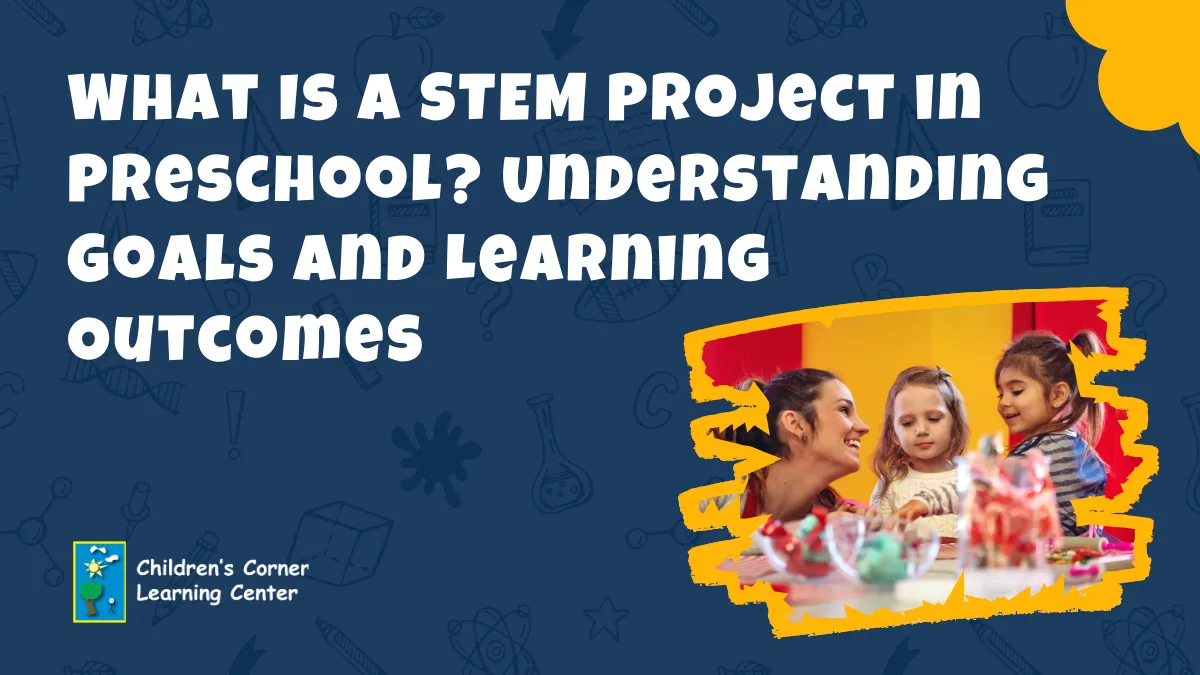STEM activities for preschoolers provide meaningful opportunities to introduce early science, technology, engineering, and math concepts through play-based learning. These activities encourage exploration, problem-solving, and hands-on discovery, helping young children build foundational skills in a developmentally appropriate way. By integrating STEM into daily routines, educators support cognitive growth while fostering curiosity and confidence in the classroom.
Whether children are building structures, observing nature, or experimenting with simple materials, each experience lays the groundwork for critical thinking and creativity. Early exposure to STEM supports academic readiness and inspires a love for learning. With thoughtful guidance and engaging tasks, STEM activities become powerful tools for developing young minds.
 STEM learning in early childhood introduces young children to critical concepts in science, technology, engineering, and mathematics through hands-on, play-based activities. These experiences help develop critical thinking, creativity, and problem-solving skills while allowing preschoolers to explore the world around them. Fun STEM activities combine curiosity, movement, and experimentation in educational and age-appropriate ways.
STEM learning in early childhood introduces young children to critical concepts in science, technology, engineering, and mathematics through hands-on, play-based activities. These experiences help develop critical thinking, creativity, and problem-solving skills while allowing preschoolers to explore the world around them. Fun STEM activities combine curiosity, movement, and experimentation in educational and age-appropriate ways.
 A STEM project in preschool is a guided, hands-on learning experience that integrates science, technology, engineering, and math developmentally appropriately. These projects are designed to nurture problem-solving, collaboration, and curiosity through purposeful exploration. While they may appear simple, STEM projects have clear goals supporting early learning and foundational skill development.
A STEM project in preschool is a guided, hands-on learning experience that integrates science, technology, engineering, and math developmentally appropriately. These projects are designed to nurture problem-solving, collaboration, and curiosity through purposeful exploration. While they may appear simple, STEM projects have clear goals supporting early learning and foundational skill development.
What Are Some Fun STEM Activities? Engaging Ideas for Young Learners
 STEM learning in early childhood introduces young children to critical concepts in science, technology, engineering, and mathematics through hands-on, play-based activities. These experiences help develop critical thinking, creativity, and problem-solving skills while allowing preschoolers to explore the world around them. Fun STEM activities combine curiosity, movement, and experimentation in educational and age-appropriate ways.
STEM learning in early childhood introduces young children to critical concepts in science, technology, engineering, and mathematics through hands-on, play-based activities. These experiences help develop critical thinking, creativity, and problem-solving skills while allowing preschoolers to explore the world around them. Fun STEM activities combine curiosity, movement, and experimentation in educational and age-appropriate ways.
Exploring Science Through Everyday Observations
Simple science activities allow preschoolers to observe changes, ask questions, and make predictions. These activities use common materials and help children understand cause and effect.- Color mixing with water and food dye: Teaches observation and color recognition.
- Melting ice experiments: Demonstrates how temperature affects solids.
- Growing seeds in clear cups: Shows the life cycle of a plant.
- Floating and sinking objects: Encourages prediction and comparison.
- Exploring shadows and light: Introduces basic physical science concepts.
Technology and Problem Solving in Early Learning
In a preschool setting, technology does not always mean devices. It can include tools and materials that help children explore how things work.- Using magnifying glasses: Encourages observation of fine details.
- Simple coding toys or apps: Introduce sequencing and direction.
- Listening centers: Support language development and comprehension.
- Cause-and-effect toys: Help children understand mechanical functions.
- Sorting games with buttons or blocks: Reinforce logic and patterns.
Building and Engineering with Purpose
Engineering activities use open-ended materials and invite children to construct, balance, and problem-solve. These tasks are ideal for collaborative play and spatial awareness.- Block structures and ramps: Support balance and stability exploration.
- Stacking cups or boxes: Encourage experimentation with height and shape.
- Bridge building with craft sticks: Teaches planning and testing.
- Marble runs: Develop sequencing and prediction.
- Constructing towers with various materials: Promotes decision-making and trial-and-error learning.
What Is a STEM Project in Preschool? Understanding Goals and Learning Outcomes
 A STEM project in preschool is a guided, hands-on learning experience that integrates science, technology, engineering, and math developmentally appropriately. These projects are designed to nurture problem-solving, collaboration, and curiosity through purposeful exploration. While they may appear simple, STEM projects have clear goals supporting early learning and foundational skill development.
A STEM project in preschool is a guided, hands-on learning experience that integrates science, technology, engineering, and math developmentally appropriately. These projects are designed to nurture problem-solving, collaboration, and curiosity through purposeful exploration. While they may appear simple, STEM projects have clear goals supporting early learning and foundational skill development.
Purpose and Structure of Preschool STEM Projects
STEM projects in preschool are typically short-term investigations that encourage them to observe, ask questions, and find solutions through experimentation. Educators guide these projects but allow room for creativity and independent thinking.- Inquiry-based: Children are encouraged to explore and discover answers on their own.
- Hands-on learning: Activities involve physical interaction with materials.
- Cross-disciplinary: Concepts from multiple subjects are integrated.
- Child-centered: Projects are designed around the interests and developmental level of the children.
- Process-focused: Emphasis is placed on exploration, not just outcomes.
Key Learning Goals and Developmental Outcomes
STEM projects support several growth areas by providing meaningful, real-world contexts for learning. Through these projects, children build foundational skills that extend beyond academic content.- Cognitive development: Children learn to observe, compare, sort, and make predictions.
- Language development: Projects encourage discussion, question-asking, and vocabulary expansion.
- Fine motor skills: Using tools and materials strengthens coordination and control.
- Social-emotional skills: Collaboration promotes sharing, patience, and teamwork.
- Early math and science understanding: Concepts such as measurement, counting, and physical properties are introduced.
Examples of Common STEM Project Themes
Preschool STEM projects often center around familiar themes that connect to children’s everyday experiences and natural interests.- Building a boat that floats: Combines engineering and problem-solving.
- Exploring plant growth: Introduces life sciences and observation skills.
- Creating a bridge from blocks: Teaches balance, stability, and planning.
- Designing a simple ramp: Demonstrates motion and gravity.
- Sorting and graphing objects: Encourages early data skills and categorization.
What Is an Example of a STEM Activity? A Closer Look at Hands-On Exploration
STEM activities in preschool are most effective when they invite children to investigate, create, and experiment using everyday materials. One example that incorporates all four STEM components—science, technology, engineering, and math—is the “Build a Bridge” challenge. This activity encourages problem-solving, collaboration, and foundational skill-building in a playful, engaging format suitable for young learners. Activity Overview: Build a Bridge Challenge In this hands-on STEM activity, preschoolers are invited to design and develop a bridge that can hold the weight of small objects, such as toy animals or blocks. Children explore balance, structure, and design using craft sticks, tape, blocks, and paper.- Objective: Build a bridge between two surfaces holding a designated object.
- Materials: Craft sticks, tape, paper, toy animals or small blocks, books, or boxes as supports.
- Setup: Place two books a short distance apart and present the materials.
- Process: Encourage children to experiment with different ways to span the gap.
- Observation: Have children test and adjust their designs based on what works.
Skills and Concepts Explored
The bridge activity touches on several core learning areas while allowing children to explore independently and collaboratively.- Science: Children observe how materials behave and explore balance and gravity.
- Technology: Using tools like tape and scissors introduces basic tool use and construction logic.
- Engineering: Designing, building, and modifying the bridge models real-world problem-solving.
- Math: Children count blocks, compare lengths, and measure spans to refine their designs.
Why This Activity Is Effective
The “Build a Bridge” challenge is effective because it is child-directed, goal-oriented, and adaptable for various developmental levels. It promotes resilience through trial and error, encourages verbal expression as children explain their ideas, and supports collaboration in small groups. Through structured yet playful exploration, preschoolers gain confidence and foundational knowledge that prepares them for more advanced STEM learning in the future.How STEM Supports Early Childhood Development
STEM education plays a significant role in early childhood by supporting key areas of development through exploration, discovery, and hands-on learning. Science, technology, engineering, and math activities enrich academically and promote essential cognitive, motor, and social-emotional skills. When introduced through play-based methods, STEM becomes a natural part of preschoolers learning about their environment and building lifelong learning habits.Cognitive Growth and Critical Thinking
STEM activities encourage children to think logically, predict, and solve problems. These early cognitive experiences help lay the groundwork for future academic learning.- Observation and analysis: Children learn to notice patterns, compare results, and draw conclusions.
- Cause and effect: Experiments show how actions lead to specific outcomes.
- Sequencing and planning: Projects require step-by-step thinking and organization.
- Memory and recall: Repeating activities help children retain and apply information.
- Decision-making: Choosing materials and methods fosters independent thinking.
Development of Motor Skills
STEM tasks often involve manipulating tools and materials, promoting fine and gross motor development. These physical actions are critical for writing, self-care, and classroom participation.- Measuring and pouring: Strengthens control and coordination.
- Using tools like scissors or droppers: Develops fine motor precision.
- Building with blocks or connecting items: Supports spatial awareness and dexterity.
- Sorting and counting objects: Encourages hand-eye coordination.
- Balancing or assembling structures: Enhances muscle control and planning.
Social and Emotional Learning Through Collaboration
STEM activities frequently involve group interaction, which helps children practice communication, cooperation, and emotional regulation.- Sharing materials: Builds patience and respect.
- Working in pairs or teams: Encourages listening and turn-taking.
- Expressing ideas: Supports language development and confidence.
- Handling frustration: Teaches resilience and problem-solving.
- Celebrating outcomes: Reinforces motivation and self-esteem.









